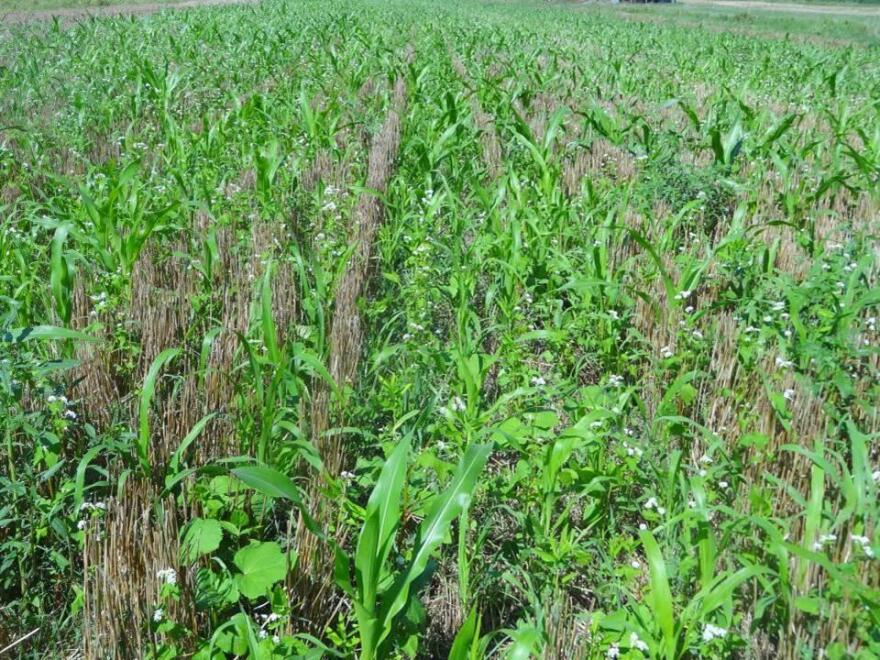Global temperatures have increased 1.9 degrees Farenheit since 1880, and 19 of the 20 warmest years on record have occurred since 2001, according to data provided by NASA's Vital Signs of the Planet.
And those changes are affecting Missouri’s top industry: agriculture.
According to NASA, about half of sunlight reaching our atmosphere reaches Earth's surface where it's absorbed and then radiated upward in the form of infrared heat. But increased greenhouse gases in the atmosphere are absorbing about 90 percent of that heat and then sending it back toward the Earth's surface.
The concentration of carbon dioxide in the atmosphere has increased over the last century due to the burning of fossil fuels like coal and oil, according to NASA.
Climate change is expected to continue to present challenges for the agricultural industry in the future.
Fields are staying flooded for entire crop years. And warmer temperatures could mean Missouri farmers will see more frequent periods of drought, reduced crop yields and decreased milk production.

“The trend in the Midwest is wetter winters, wetter springs, which makes it hard to get the crop in the ground, which makes it hard to get the field work done, to get in to do the planting, to do all the things necessary to get the crop in the ground,” said Toby Dogwiler, the head of the Geography, Geology and Planning Department at Missouri State University.
Since 1981, 24 out of 39 years or 62 percent have had above normal precipitation, according to Pat Guinan, state climatologist with the Missouri Climate Center at the University of Missouri. And data he provided to KSMU show that over the past few decades, Missouri has witnessed an above average trend in rainfall events that produce three or more inches of rain.
And scientific data show those precipitation patterns could become more amplified in the future as climate change continues, said Dogwiler.
According to NASA, "projections of future climate over the U.S. suggest that the trend toward heavy precipitation events will continue." And the organization said the Intergovernmental Panel on Climate Change (IPCC) forecasts a temperature increase of 2.5 to 10 degrees over the next century. The IPCC is made up of more than 1300 scientists from the U.S. and other countries. And according to NASA, a few decades from now, Earth is expected to be warmer than it's been in a million years.
Dogwiler predicts that as temperatures warm, farmers will have to switch to growing crops that used to be grown further south. For example, he said parts of Missouri could become suitable for growing cotton.
"And that's not a minor issue," he said. "If you're used to growing corn and then all of a sudden you're in cotton country or cotton country's moved to you, that's a whole different set of implements and machinery and also know-how in terms of growing those crops."
And, according to Dogwiler, the climate could switch back and forth for awhile. So, there might be a couple of years of the old climate trends and then a couple of years of the new climate trends and so on, with shifts in sort of which crops may be best, he said.
"You could be in the Cotton Belt for a couple of years and then shift back to, you know, more northerly crops, and I think this could just wreak a lot of havoc on farmers and their ability to plan for the long and the short term," he said.
Farmers can influence a government's response, policy
The U.S. needs to be taking action to slow climate change, Dogwiler said. The more time that passes, the more expensive it will be to adapt.
He believes farmers can make a difference in governments’ response to climate change since they have a lot of power both locally and nationally.
“If farmers demanded that politicians address some of these climate change issues, the politicians in the Midwest and in Washington will hear that,” he said.
Some farmers are taking action by adopting regenerative agriculture practices, including planting cover crops, which can improve soil health and pull carbon from the atmosphere.

Karl Thidemann, co-founder of Soil4Climate, said that can have a big impact. He pointed to a talk by American soil scientist, Dr. Rattan Lal.
“It is his estimate that within 80 years, which is to say a human lifetime, we could remove the entire amount of excess carbon in the atmosphere through a variety of practices," Thidemann said. "It would involve transforming agriculture worldwide. And we’re talking about removing approximately 300 billion tons of carbon from the atmosphere.”
But he said the amount of carbon humans are releasing into the atmosphere through the burning of fossil fuels needs to be addressed, too.
As Mike Burton, professor in the Environmental Plant Science and Natural Resources Department at Missouri State University, spends time with his students, he thinks there’s reason for hope.
He believes they are as environmentally aware as students in the 1960s.
"So, with that concern, if they can bring whatever moderation or expansion of that enthusiasm as needed from real data as opposed to click bait sorts of stories that make us being a scientist trying to communicate real results more difficult, I think that there is reason for optimism."
And, according to Burton, students can, with humility, approach their parents and grandparents who are farmers and suggest changes.




